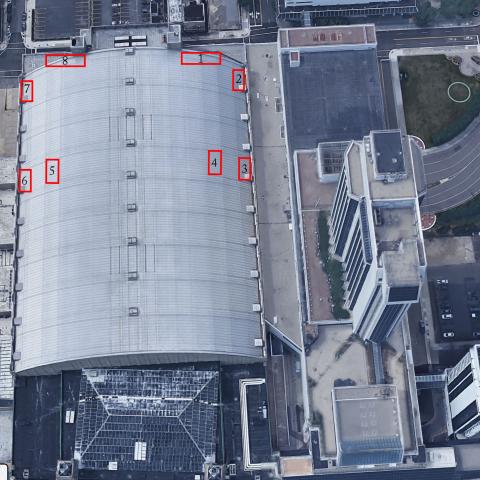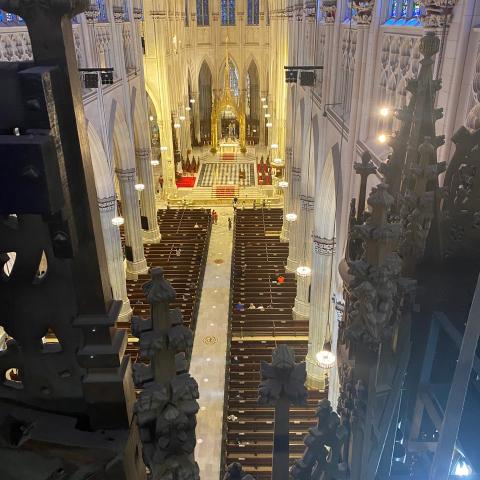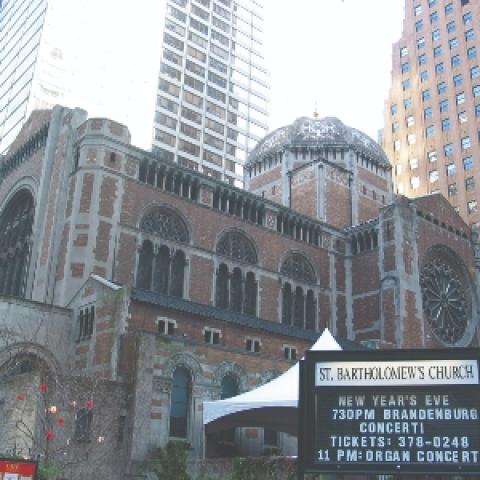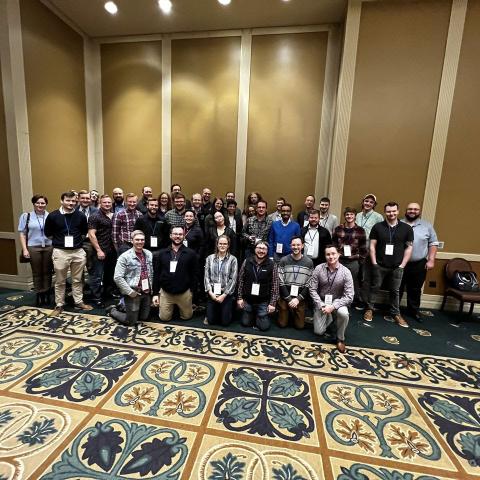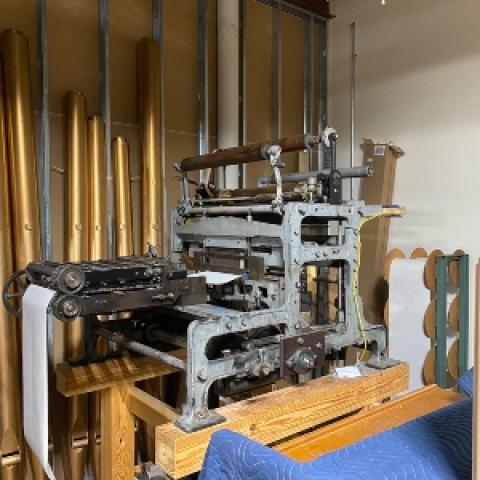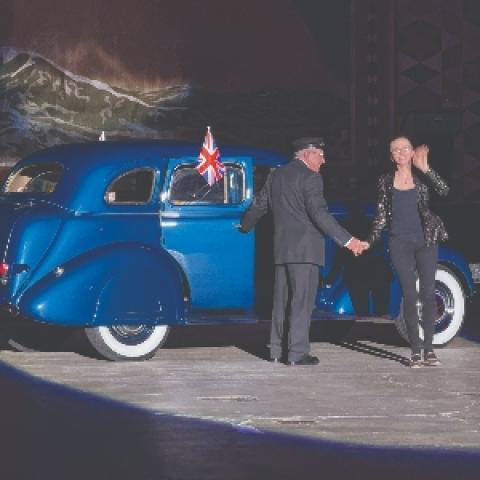
“Just can’t wait to get on the road again.”1
For over fourteen months during the extraordinary time of Covid, Wendy and I stayed at our house in Maine, leaving our apartment in virus-rich New York City vacant. Until late in 2020, Lincoln County where we live in Maine was counting fewer than twenty new cases each week, and we figured we would stay there until vaccinated. Like so many people around the country, we altered our working lives using Zoom and FaceTime instead of meeting in person. We set up our offices as “Zoom Rooms,” sometimes wearing “go to office” tops over jeans or shorts.
I received my first vaccination shot on my sixty-fifth birthday in mid-March. Once I was on the schedule, I started planning a trip, and I hit the road sixteen days after my second shot. I visited three organ building workshops, a half-dozen organs that were coming on the market, a couple iconic organs (one can never see enough of them), and a church where my colleagues are helping install an important new organ. I drove south on a western route through Virginia and Tennessee to Birmingham, across to Atlanta, and north on an eastern route home through North Carolina and Virginia to meet Wendy for a few days on the Jersey Shore. It was my re-immersion in the craft I have been working in for more than forty-five years, and I came home refreshed and newly inspired.
Variety is the spice of life.
Pipe organs come in all sizes, shapes, and colors. We have organs that are large and small, electric and mechanical, freestanding in cases and enclosed in chambers. We have organs based on ancient European concepts and models, and organs that are purely American, and my trip spanned the far reaches of the organ world. I visited the workshops of Noack Organ Co. (Georgetown, Massachusetts), Taylor & Boody Organ Builders (Staunton, Virginia), and Richards, Fowkes & Co. (Ooltewah, Tennessee), each of which works with a small staff of dedicated artisans building hand-crafted organs in free-standing hardwood cases. Noack is currently working on an organ with sixty stops, and I was lucky to see it being loaded on a truck at the workshop followed by the beginning of its installation at the Catholic Cathedral of Saint Paul in Birmingham, Alabama. Taylor & Boody’s current project is a thirty-eight-stop job for Wheaton College in Illinois, and Richards, Fowkes & Co. is working on a thirty-one-stop organ for Saint Andrew’s Episcopal Church in Ann Arbor, Michigan.2 Besides a tour and rich conversations in their workshop, Bruce Fowkes and Ralph Richards took me to see the spectacular four-manual organ by John Brombaugh at Southern Adventist University in Collegedale, Tennessee. I am heartened that during this uncertain time, these three outstanding firms are all building substantial instruments at the same time. You can see details about each organ on the builders’ websites.
These three builders are known for building tiny organs as well as instruments with sixty or more stops. Continuo or practice organs with three or four stops are the hummingbirds of pipe organs, and modest instruments with fewer than twenty stops are little gems with gorgeous, intimate voices and carefully balanced choruses, but the big bird of my trip was the behemoth all-American organ in Boardwalk Hall in Atlantic City, New Jersey, an organ with single divisions that include more than thirty stops. (See the cover feature of the November 2020 issue of The Diapason.)
In the May 2021 issue of The Diapason, pages 12–13, I wrote about the efforts of curator Nathan Bryson and his staff of assistants and volunteers to protect the organ during the recent demolition by implosion of the adjacent Trump Hotel and Casino, so the organ was fresh on my mind when I started planning my trip, and I invited myself for a visit. Nathan was the consummate host for my day in the largest organ in the world.
The organs at Boardwalk Hall and the Wanamaker Store (now Macy’s) have each been considered the largest in the world. Now that I have visited both with their curators as my guides, I will take the plunge and explain how an organ earns such a title. At the moment, the Boardwalk Hall Organ is about 53% playable, so the Wanamaker Organ can safely claim to be the largest fully playable organ in the world. The Historic Organ Restoration Committee that oversees the organ in Boardwalk Hall has ambitious plans to bring the organ to fully functional condition. Stay tuned. I will report it when it happens.
The Wanamaker Organ has 464 ranks while Boardwalk Hall has a mere 449, a difference of fifteen ranks, the size of a modest organ, so it wins in the category of most ranks. The Wanamaker organ has 75 independent pedal ranks with 32 pipes (29 notes fewer than manual ranks), while many of the ranks in the Boardwalk Hall Organ have up to 85 notes, accounting for extensive unification and making use of the extended lower three keyboards which have 85, 85, and 75 notes, giving the organ a total of 33,112 pipes compared to the impressive 28,750 pipes in the Wanamaker Organ. That’s a difference of 4,362 pipes, or the equivalent of a seventy-rank organ!
An 85-note rank of pipes allows a continuous scale from low CC of 8′ to high c′′′′′′ of 2′, or as in the case of several ranks in Atlantic City, from low CCCC of 32′ to high c′′′′ of 8′. Unbelievably, there is a 64′ Dulzian Diaphone with 85 notes that goes all the way to the top of 16′. Scrolling down the endless stoplist, I count one 64′ rank (85 notes), eight 32′ ranks, and sixty 16′ ranks. A count like that makes a big organ. You can count for yourself. There are comprehensive lists of ranks, stops, console layout, and pistons and controls at www.boardwalkorgans.org. It would be difficult to calculate accurately, but it is my gut feeling that the Boardwalk Hall Organ weighs a lot more than the Wanamaker Organ.
Vulgar or beautiful?
I have had a number of encounters with the Wanamaker Organ over the past twenty years, both in intimate, personal, and comprehensive visits, and in swashbuckling public performances. This was my fourth visit to Boardwalk Hall, but the first time I heard the organ.3 I was aware of both organs when I was growing up, long before either had any meaningful restoration, but as I was in the thrall of the “Tracker Organ Revival,” dutifully learning early fingerings at Oberlin, I was not creative or open-minded enough to make space for them in my musical comprehension. I assumed that they existed to take part in the biggest-loudest-fastest competitions that lurk throughout our society. How could something with more than four hundred ranks be anything more than the pipe organ equivalent of a freight train? Artistic content? Musical sensitivity? Phooey. I was wrong.
I was fortunate to have experience renovating larger electro-pneumatic organs early in my career, and when I became curator of the organs at Trinity Church Copley Square and The First Church of Christ, Scientist (The Mother Church), both in Boston, I was immersed in the grandeur of super-sized organs. The Aeolian-Skinner organ at The Mother Church is huge (237 ranks and 13,500 pipes), but less than half the size of those in Boardwalk Hall or the Wanamaker Store. While the organ at Trinity Church (actually two instruments, Chancel and Gallery, playable from one console) was smaller in number of ranks, it was an important part of my understanding of large organs because of the weekly recital series there. Each Friday, I heard a different organist play the instrument. Some were bewildered, bamboozled, even defeated by its complexity, but those organists who could make it sing taught me how a large and varied organ with divisions in four separate locations could combine to produce expressive sweeps, from thundering fortissimos to shimmering echoes that melted away into the frescoed walls.
If a finely crafted organ with mechanical action brings the intimacy of chamber music to the fingers of the organist, the large romantic organ allows the musician to paint majestic landscapes. And the mega-monumental symphonic organ allows expression ranges unheard of otherwise. What do you do with an eighty-rank string division? Paint pictures.
In the arena
When I first arrived at Boardwalk Hall, Nathan “fired up” the organ using files made by Peter Richard Conte, the Grand Court Organist of the Wanamaker Organ, along with several other creative players, and stored in the playback system. Peter is unusual among organists because of his affinity for these exceptional organs. While most of us are used to registering a chorale prelude with a cornet for the solo line and a few soft flutes and a Subbass for accompaniment, Peter is a sonic wizard with thousands of stop tabs and hundreds of other controls that allow him to command the dozens of divisions scattered about in the vast room. Sometimes he throws on a big row of stop tablets as if he was playing a glissando on the keyboard, but more usually, he programs pistons with intricate combinations using stops by the hundreds.
Boardwalk Hall is 456 feet long and 310 feet wide with a barrel-vaulted ceiling that peaks at 137 feet. Its seating capacity is over 15,000, and it is regularly used for rodeos with bull-riding competitions (they truck in enough dirt to simulate a prairie), indoor auto racing, ice hockey, basketball, soccer, and even college football. It was the site of the first indoor helicopter flight, and it is home to the Miss America Pageant. It was surreal to stand alone on the empty floor of the semi-lit hall listening to the organ do its thing with the help of Peter’s bytes. The two main organ chambers are separated in space by the hundred-foot-wide stage. The chamber lights were on, and great swaths of expression shutters were in full view, swishing and fluttering like sensuous thirty-foot eyelashes. This was not “All Swells to Swell.” The many sets of shutters were moving in contrary motion, each responding to the rises and falls of individual voices in the complex arrangements. Waves of sound ebbed and flowed like the surf on the sandy beach on the other side of the iconic boardwalk, cascades of notes morphed into fanfares, melodies were “soloed out” as if by a platoon of trombones or by four dozen violinists playing pianissimo in unison. This is the very essence of the symphonic organ, its dazzling array of controls allowing the single musician to emulate the actual symphony orchestra.
Sweeping a beach
The Aeolian-Skinner at The Mother Church taught me what is involved in caring for a large organ. “Touching up the reeds” can take all day—there are forty-one of them. But that organ lives in a building with perfect climate control. When you have more than 450 ranks in a building that is also home to rodeos and auto racing, you have a hefty tuning responsibility. Curator Nathan Bryson manages a team of professionals and volunteers who are methodically moving through the organ rebuilding blowers, releathering windchests, refurbishing organ pipes, while maintaining the organ for daily recitals and many special events.
The Boardwalk Hall Organ was built by Midmer-Losh of Merrick, Long Island, New York, during the Great Depression at a cost of over $500,000 and was completed in December of 1932. It is housed in eight chambers: Left Stage, Right Stage, Left Forward, Right Forward, Left Center, Right Center, Left Ceiling, and Right Ceiling. You can see the layout in a photo accompanying this column in the May 2021 issue. Getting a handle on which stops and which divisions are located in which chamber is the first challenge of learning one’s way around the vast instrument. The two Stage Chambers comprise what I perceived to be the main organ. They are huge and jammed with some of the largest organ stops in the world. There are stops on wind pressure of 100 inches on a water column, an absolute hurricane of air.
When the organ blowers are turned on and the instrument fills with wind, windchests expand visibly, as if the doctor told you to “take a deep breath.” The fifteen-foot-long walls of the pressurized room that houses the organ’s main electro-pneumatic switching equipment move so dramatically that I squinted, wondering why the thing does not burst. During renovation, several of the windchests on 100-inch pressure were replaced using more robust engineering, informed by the difficulty of building a wooden vessel to contain such high pressure.
Tuning those gargantuan ranks is a three-person job, one at the console, one in the middle of the hall where it is possible to hear pitches and beats, and the third (with industrial hearing protection and audio headphones) manipulating the pipes. You could try using a starting pistol to signal “next,” but you wouldn’t be able to hear it.
Beyond the endless work of restoring, renovating, tuning, and maintaining this organ, perhaps the most difficult and important work has been reintroducing the city and state governments to the ongoing stewardship of the instrument. A vast auditorium with such an unmusical array of uses seems an unlikely home for a pipe organ, and the people who have been working with and on the organ have been effective ambassadors, sharing the unique qualities of the largest organ in the world. If you would like to help, visit that website and look for the “Donate Now” button.
Look to the future.
After fourteen months at home, it was a joy to be back on the road. My thanks to Didier Grassin of the Noack Organ Company, Ralph Richards, Bruce Fowkes, John Boody, and Nathan Bryson for sharing their work and philosophies with me, and above all, for sharing the joy and pleasure of “knocking around about pipe organs.” Three cheers for all the wonderful work underway on organs both old and new. If this is a taste of the new normal, I am ready to ride.
Notes
1. Willie Nelson.
2. By coincidence, one of Wendy’s cousins is on the organ committee at Saint Andrew’s.
3. In 2010, the Organ Clearing House built the “Blower Room” set for the Saint Bartholomew funeral scene in the spy-thriller movie, Salt, starring Angelina Jolie and directed by Philip Noyce. All the sets including the barge, the presidential bunker, and the CIA offices were constructed in retired Grumman aircraft hangars in Bethpage, New Jersey, where the Lunar Excursion Module was built. Our set included a couple big Spencer blowers that we had in stock and a huge electro-pneumatic switching machine borrowed from the “other” organ at Boardwalk Hall (a four-manual Kimball in the adjacent theater). I transported the machine in both directions in rental trucks. The set decorator thought the rig was complicated enough that I should be present for filming. I stood around while Ms. Jolie jumped through walls dozens of times, until I heard over the PA system, “Organ guy to the crypt, organ guy to the crypt.” The leading lady greeted me with hand outstretched, “Hi, I’m Angie.” I described that she should shoot the regulating chain to make the bellows go haywire and cause the mass cipher that would disrupt the funeral. (We provided the hardware, and special effects provided the action.) She said, “I can’t shoot that.” I replied, “I’ve seen you shoot.” I watched the single take on Mr. Noyce’s monitor and had the honor of shouting “Action!” at his signal, my twelve seconds in Hollywood, another chapter from the life of an itinerant organ guy. Curious? You can stream it on Netflix. And the nice thing about building a movie set? They don’t require a warranty.
Photo caption: Seven keyboards and 1,235 stop tablets, as big as they get. Midmer-Losh organ, Boardwalk Hall, Atlantic City, New Jersey. (Manuals I and II have 85 notes, Manual III has 75 notes, and manuals IV, V, VI, and VII have the usual 61.) (photo credit: John Bishop)

